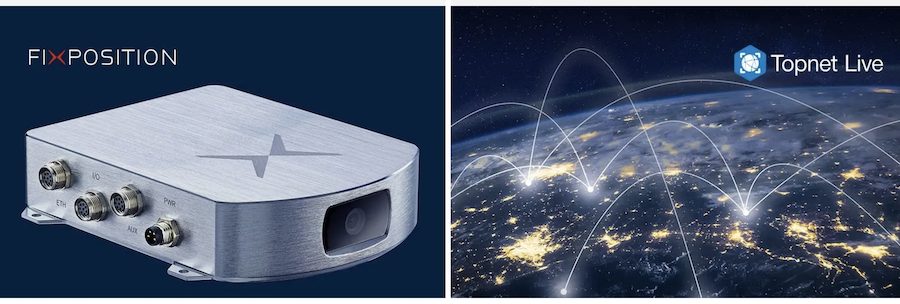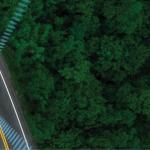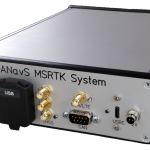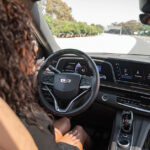Fixposition integrates Topnet Live, using precise and reliable corrections to bring autonomous systems to more applications and more users than ever.
“At Fixposition, we are leading the way towards enabling scalable autonomy,” said the company’s CEO Zhenzhong Su. “The fact is that once you have centimeter-accurate GNSS, and you can fuse that with a stable, vision-based collision avoidance system, in many cases developing an affordable and scalable autonomy solution is not difficult at all.”
Fixposition AG is a Swiss company delivering high-precision global positioning solutions, combining computer vision techniques and satellite navigation to provide accuracy in the open field and in GNSS-challenged environments. When GNSS signals are disrupted, Fixposition vision fusion takes over to maintain the global positioning accuracy. The company’s mantra is ‘precise global position, everywhere’.
To provide that kind of service, Fixposition needs top-flight GNSS corrections. “Before we chose Topnet Live, we actually tested most of the services that are out there,” said Su. “After running a lot of comparisons and listening to our customers, we came up with a list of the things that really matter to them.” Fixposition’s clients’ key needs are, first and foremost, high-quality corrections. “That means one centimeter-accuracy,” Su said. “Decimeter-level won’t do the trick for the customer’s we’re serving.” These include providers of autonomous mowing software and machines, robotic tractors and road sweepers.
“The next thing they want is short time to convergence,” Su said. “It’s about good accuracy but it’s about getting it fast.” Third, they want global coverage. The Topnet Live network is one of the largest GNSS base station networks in Europe and North America. And finally, they want all of that at a good price. “Topnet Live gives us what we need,” said Su, “what our clients want, meeting all the criteria I’ve just outlined. And there’s another advantage compared to other correction services, and that’s that once you have a Topnet Live account, for example in the United States, it works everywhere, across state boundaries, Georgia, Florida, California, without any hang-ups.”
Hitting the ground running
Topnet Live is helping Fixposition customers extend precise operation into areas where it was not possible before. One of Fixposition’s clients is Greenzie, a leading software company out of Atlanta, developing fully autonomous commercial lawnmowers and industrial equipment. Greenzie partners with top OEMs to manufacture Greenzie-equipped, Robotic Ready mowers, sold at outdoor power equipment dealers throughout the U.S.
In a recent YouTube video, the company’s CEO Charles Brian Quinn, also known as ‘CBQ’, said, “This Fixposition device [shown mounted on a big Mean Green Vanquish mower] has been incredible. It includes visual odometry and a rock-solid RTK system that we love working with. We do autonomous mowing, and, previously, to get a very globally accurate position that is unaffected by a lot of the noise, like overhanging trees, we’ve had to rely on expensive hardware and software, but this device does an outstanding job of fusing the visual odometer, which is amazing, along with the RTK and the corrections that we rely on, all in one small package.”
A good start
“Our company was founded six years ago,” Su said. “We’re a spin-off of ETH Zurich, which some people call the European MIT. I still remember when I built my first prototype of RTK GPS, back in 2015 when I was doing my PhD. Now, we’re essentially a software company that develops innovative accuracy services, with deep computer vision sensor fusion.” Fixposition customers can provide additional sensory input. “If you have wheel speed, or even velocity from LiDAR, we can fuse that,” said Su. “We call what we do vision-augmented RTK. Vision RTK-2 is our main product. It’s a positioning system, so we have our own hardware.” Since May 2023, Fixposition customers are able to buy the Vision-RTK-2 bundled with a one-year Topnet Live correction services subscription.
Su said he sees many things changing, with a new movement brewing in the direction of a much wider mass-market user segment for autonomous systems. Using basic GNSS RTK, with precision powered by Topnet Live, Fixposition is pushing cost out of their positioning solution, broadening the span of affordable autonomy to encompass micro mobility, ground-based delivery robots, UAVs and the internet of things. That means a much larger total addressable market is now in play, no longer limited to the early adopters, the specialized, industrial, commercial applications like agriculture and construction.
Breaking out new markets
“I think the industrial market where we see established autonomous solutions will stay more or less the same size,” Su said. “Those users are already running their autonomous systems and are ready to pay a price for their positioning technology. For them, absolute stability and safety play a big role. Things are very different in the consumer market.” Su cited the rising tide of e-scooters now seen in numbers in cities around the world. “The volumes there are huge,” he said, “and the authorities and the operators want to know where these scooters are. So we see a demand rising for positioning precision, and with a GNSS-based solution, with a correction service like Topnet Live, we can get that accurate and affordable fix that fits their need.”
A lower price point means users can deliver products to a larger market, while at the same time stimulating consumer demand. “Once you trigger mass-market demand,” Su said, “You start to see the volumes rising. Tech providers’ costs go down and we have economy of scale.”
Again, Su is careful to distinguish these potential large-volume consumer markets from the professional user segments, where security remains a central constraining factor. “Applications like the self-driving car are operating in open-road scenarios and maneuvering in very complex environments. They need to be concerned about human safety. Now, in the mass consumer autonomy markets that we are talking about, where you can work in clearly delimited and controlled areas, this can be a relatively safe and easy environment, and what the robot is doing is rather repetitive. You designate the area, and have a good motion plan, autopilot, a good algorithm, with an affordable and stable collision avoidance system. You don’t need five LiDARs. We have a customer now using just one LiDAR for collision avoidance. LiDAR does that wonderfully, because it sends up super-dense point clouds.
With plenty of ingenuity and a clear vision for growth, Fixposition could be standing at the forefront of a new wave of precise and profitable autonomous solutions, with Topnet Live providing the edge, with fast, accurate and always available GNSS corrections.






